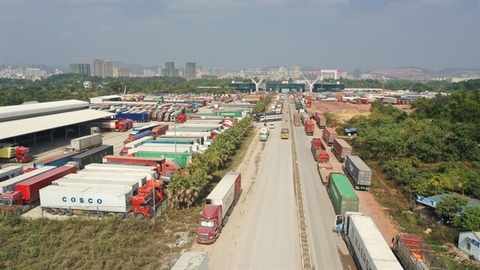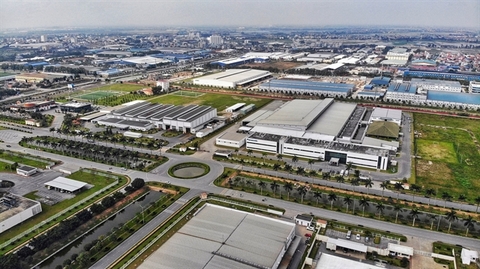
Lines of cargo trucks wait for export procedures at the Mong Cai border gate in Quang Ninh Province. Located at one end of the Eastern Highway Economic Corridor, the gate leads to large markets in China. — VNA/VNS Photo Thanh Van
As part of an initiative to form a connected sub-regional economy, the formation of the Eastern Highway Economic Corridor has been building a new development zone that will maximise the full potential of its member cities and provinces.
Officially established in July this year on the sideline of the 3rd APEC Business Advisory Council meeting, the project groups the provinces of Quang Ninh, Hai Duong, Hung Yen and Hai Phong City.
These four localities enjoy one of the leading transport infrastructure connections in the country, with one end linked to the capital city of Hanoi and the other to Quang Ninh’s Mong Cai border gate, which opens to the large markets of China.
Businesses in this zone also benefit from three international airports of Van Don, Noi Bai and Cat Bi, in addition to international seaports along the northern coast in Quang Ninh and Hai Phong.
The aim of the initiative is to create a favourable environment for trade, economic development and a thriving business community, eventually creating a growth pole in the Red River delta and the northern region.
As members of this zone, each locality can contribute strengths to the common cause of development.
Hai Phong City has special advantages in terms of seaports and logistics chain. Meanwhile, Quang Ninh Province is known for its rich resources in tourism, services, trade and production lines connected to the Chinese market.

Hai Phong City's Lach Huyen International Seaport, also known as Hai Phong International Container Terminal, is the largest modern deep-water port in the northern region. — VNA/VNS Photo Duc Nghia
Hai Duong Province has outstanding potential in human resources, land and its position as the centre of the region, as well as advantages in the mechanic and manufacturing industries.
As the locality adjacent to the capital city of Ha Noi, Hung Yen has significant prospects for industrial development and hi-tech agriculture alongside rapid urbanisation.
As the permanent coordinator, Viet Nam Chamber of Commerce and Industry (VCCI) plans to utilise its team of experts and connections within the business community for this project.
VCCI says that one of the key subjects of economic connections is enterprises. The agency looks forward to supporting the establishment and operations of regional business associations.
It also aims at practical and specific activities that bring about the best results for the sustainable economic development of the four cities and provinces in the zone.
VCCI chairman Pham Tan Cong believes that the initiative will expand the development zone in scale and depth.
He said: “When connected, the four localities will create a new space and vision on economic development, with a large scale and huge potential and advantages that create favourable conditions to drive growth in businesses, attracting quality investment projects and therefore, becoming a growth pole in the Red River Delta.
“To advance further, take firmer steps forward and achieve more on the road to prosperity, localities need to walk together to make up for each other limitations in resources, all for the common strength of the whole region.”
He also made the commitment to utilise VCCI’s strength in gathering enterprises, governmental agencies and international partners for the success of the project.

A section of the Ha Noi - Hai Phong Highway in Hai Duong Province, interchanging with National Route 10. — VNA/VNS Photo
Quang Ninh Provincial Party Secretary Nguyen Xuan Ky expects that the strong links between the four localities will open the way to opportunities and powerful project execution.
He emphasised the necessity of breakthrough policies and frameworks in workers’ housing, higher education and vocational training.
The province’s leader also expressed his wish to share human resources with other localities for common growth, as well as on building an attractive ecosystem for living, support policies, and quality public services.
Meanwhile, Hai Phong City has been actively developing the transport infrastructure for regional connections, with coastal routes and river bridges to neighbouring localities, according to the city’s People’s Committee chairman Nguyen Van Tung.
It is a move to expand the economic zone and maximise the locality’s strength in seaports and airports.

Thang Long Industrial Park II in Hung Yen Province is the base of multiple projects with foreign investments. — VNA/VNS Photo Danh Lam
Trieu The Hung, chairman of Hai Duong Provincial People’s Committee, said that while the four cities and provinces had been working together in the past, the connections had not achieved their full potential.
Under the coordination of VCCI and the agreement between the localities, it was expected that the initiative would form a major corridor not only for the North but also for the entire country, he said.
Hung Yen Province’s Party Secretary Nguyen Huu Nghia also added that this agreement was a ‘playground’ where every stakeholder has equal rights and obligations transparently in terms of policies, frameworks, planning and strategies.
At the end of 2022 and into 2023, most of the group’s activities will focus on several key areas of trade, investment, transport and logistics, production supply chain, tourism and services, hi-tech agriculture and produce processing.
They also plan to look into improving the business environment, digital transformation and connections. — VNS